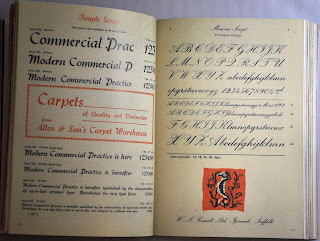This research has come from a book that I found in the library titled 'scripts.' It is a great book for research into elegant script handwriting. I am not sure about what I actually want to do with the handwriting at the minute or where the project is going to take me. I definitely need to come to a conclusion about the format that the project will take soon. What I am sure about however is what I want to explore. I want to actually learn how to write like a victorian. Then, perhaps I could design a book teaching people what I have discovered through the process of learning how to write in a specific typeface? This may make an interesting read.
I love the way that old handwriting looks and how much time was taken over the creation of making it look beautiful. It is true that the people that were able to write pre victorian era were the people that were well educated and in modern society everybody can write. Maybe this is why the art of handwriting has depleted through the decades? I just feel that so much can be learnt from the studying of handwriting. In the image above, the piece of writing is instantly recognised as an old document because of the paper that it is printed on, which has discoloured over time, an the fact that it is an elegant script font writing. The question that I am asking myself as I am conducting this research is does this style of handwriting have a place in modern society? If you saw a sign that was advertising a butchers in this handwriting style, what would it be suggesting about the butchers? We have become accustomed to seeing really poorly written signs for cafe opening times, market stall sales, fruit and veg shops etc that this is now what we expect. Would it suggest that the cafe was dated if the owner decided to write the sign in a victorian style? Back to the research, I love the way that the writer in this piece has used elongated flourishes in titles and the variance in stroke width. The really delicate, fine lines make this writing sophisticated. If it was all one thickness, I think that it would loose some of its elegance and charm.
This is really interesting research above. It is a continental writing style which I am not too interested in exploring, I want to focus on Victorian writing. However, there is a grid behind the writing in this research which suggests how the letters are formed. This is something that I want to explore. I want to show the victorian handwriting as an artform. I want to convey the amount of perserverance that went into perfecting fluent writing. I want to do the handwriting justice and convey that the modern man does not pay enough attention to the way that they write. I want to show that people have become lazy and that we should all take something from a bye gone age of writing style that is part of our heritage. I am going to explore initially the construction of Victorian handwriting letterforms. I will construct grid lines to work to, much like this research here.
In the above image, I think that the writing is set beautifully. This is an engraved typeface called Palace script. It is an english typeface developed in the Victorian Era. Here it is called palace script. I have also seen it called Copperplate round. It is an elegant victorian writing style and the typeface that the Victorians learnt to write in at school. Perhaps the challenge that I face is to show that a beautiful script handwriting does have a place in concemporary society? Maybe I should try and develop the Victorian Handwriting style so that it takes a more modern form?






No comments:
Post a Comment